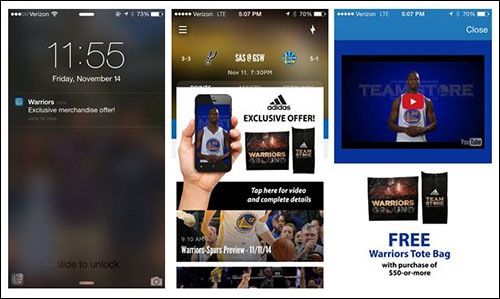Feb 10, 2015Mobile technology company Signal360 is selling a proximity solution that includes beacons, a software developer's kit (SDK) and its content-management system (CMS) software, to integrate its beacon-based SDK with a brand's existing app. The solution also comes with Signal360's beaconing devices that not only transmit Bluetooth Low Energy (BLE) signals, but also emit an inaudible tone that approximately 95 percent of smartphones are capable of receiving, in order to provide redundancy for app-using phones that have their Bluetooth radio turned off.
The New York company's solution is currently in use by Italian clothing retailer OVS, as well as by University of Michigan sports teams, and by the Golden State Warriors professional basketball team. The company reports that additional pro teams will announce their use of the technology in the near future.

The Bay-area NBA team began using the technology in March 2014, and the system has been deployed throughout the 2014-2015 basketball season to welcome fans to the Oracle Arena, in Oakland, Calif., as well as offer merchandise when visitors are near the team store, and notify them of seat upgrade options as they approach high seats situated far above the court. "We have 20,000 actively engaged, passionate fans at every home game," says Kevin Cote, the Warriors' senior director of digital, "and we want to encourage and empower them to use their mobile devices to truly enhance their experience."
The company providing this technology, Signal360—formerly known as Sonic Notify—was founded in 2011. Alex Bell, the company's founder and CEO, initially envisioned a mobile app that used inaudible audio transmissions from beacons to identify the locations of buses and commuters in New York City, thereby providing those individuals with information regarding bus arrival times. For instance, beacons attached to buses or bus stops could send audio transmissions that would be captured by phones, and the app would then calculate the location of the commuters or vehicles.
"The beacons answer the simple question, Is the user on a bus or subway, or not?" Bell explains. "Because each beacon has a unique ID, we can tell which users are on the same bus, and where the buses are." His company obtained a patent on the technology; however, he says, the bus-location solution would require nearly 100 percent rider participation to be fully effective, since transmissions from just a few phones would not provide sufficient data to pinpoint a vehicle's location, while there was considerable interest in Signal360's solutions instead from retailers. The company then began developing a location-based solution for the retail and sports stadium markets.
In 2013, before Apple launched its iBeacon Bluetooth beacon platform, Bell's company decided to modify and enhance its own devices to emit both inaudible tones and BLE signals. Nearly all phones can receive the inaudible 20 kHz tones encoded with the same unique ID number that the device transmits via BLE, while most smartphones can also receive BLE transmissions. The inaudible tone range can vary from 5 feet to 300 feet (the equivalent range of the beacon's Bluetooth transmissions), depending on the needs of the company deploying the beacons. The form factor of the devices, which Signal refers to simply as beacons, also varies according to a particular customer's requirements. The most common version measures 3.0 inches by 4.75 inches and plugs into a standard wall power outlet.
The advantage to including the inaudible tones in the solution, says Lauren Cooley, Signal360's sales and marketing executive VP, is the app's ability to receive a signal even when a phone's Bluetooth function is deactivated. She says her company's own research has found that 35 percent of its beacon notifications are delivered to phones that do not have BLE functionality turned on. "If not for the audio delivery," she notes, "those devices would not have received a notification."
Signal360's solution consists of the beacon, an SDK and back-end CMS software managed on a hosted server. Customers pay a monthly service fee that varies according to the application. The beacons can be either leased or purchased.
Through its European distributor and reseller, Ecods, Signal360 sold its solution to fashion retailer OVS in 2014, which has updated its own app to work with Signal360's beacons. In the meantime, Signal360 is partnering with Ecods to offer the technology to other Italian retailers using Ecods' Proxee mobile app, available via the Google Play and iTunes websites.
OVS operates 569 shops throughout Italy, all of which have at least one Signal360 device transmitting to customers' phones, as long as they have downloaded the OVS app, which is available for both Android devices, through Google Play, and for iPhones and iPads, via iTunes. In addition, Ecods had installed the beacons at other small retailer sites and approximately 75 percent of movie theaters in Italy.
The OVS app allows consumers to receive transmissions—as they walk near the entrance of an OVS or other participating store—that display promotional data about products inside the store. As they walk through some OVS store locations, beacons in different departments also transmit content specific to products in the immediate area, such as a sale on women's jeans. The Italian installations took place in late 2014, Cooley says.
The University of Michigan installed Signal360 beacons in August 2014 at its Michigan Stadium, where the school's football team plays, and at its Crisler Center, where its basketball team plays. The school's athletics department is using the technology to draw more enthusiasm from its teams' more than 120,000 fans. The department already offered a Michigan Athletics app known as HAIL, available at Google play and iTunes. The athletics department used loyalty rewards company SuperFanU to create content linked to each beacon. The university employed Signal360's SDK to enable the HAIL app to work with Signal360's beacons, which trigger content to be displayed on phones, such as greetings at the stadium's entrance, as well as concessions offers and promotional content from the merchandising areas.
The Golden State Warriors also used the SDK to include support for Signal360's technology in its official mobile app, available at iTunes and Google Play. The beacon placement, Cooley says, is designed to provide useful content to visitors at the most appropriate locations, rather than inundating them with content. "What we want to provide is a very intelligent tap on the shoulder," she explains. For example, the firm found that the best place to offer seat upgrades is at the point at which ticket-holders reach the top of the escalator at the highest point of the stadium—that is, the moment they realize just how far they are from the action.
According to Cote, the Warriors' priority is to ensure that the content provided by the beacons is of immediate benefit for the fans, so that they aren't being inundated with unnecessary interruptions. "We focus on three specific use cases for each game," he says, "with additional use cases and tests conducted throughout the season." Such use cases include a welcome message, exclusive offers from the Team Store and seat upgrade notifications. "Fans have definitely responded favorably" to date, he adds.
What's more, the system is designed not to send messages in duplicate, so that if a user, for example, has passed a merchandising area and has already received promotional content, he or she will not get that same message again, even if that person passes the area more than once.
Since the Golden State Warriors installation, which was taken live during the first quarter of 2014, Cote says the promotional messages triggered by the beacons have had a positive effect. "Fans taking advantage of the game-by-game merchandise offer associated with the beacon notification are spending an average of 93 percent more than the overall average merchandise transaction," he reports.
Signal360 is also working with X3 Productions to provide its technology at exhibits in National Geographic Society's Indiana Jones and the Adventure of Archaeology interactive exhibit, which is presently touring North America and began at the Fort Worth Museum of Science and History, located in Fort Worth, Texas. The show features Indiana Jones film props, set designs and information about historical myths, such as the Ark of the Covenant and the Holy Grail. With the Signal360 beacon technology, users of the exhibition's app can view content about different exhibits within the museum, based on their location.



